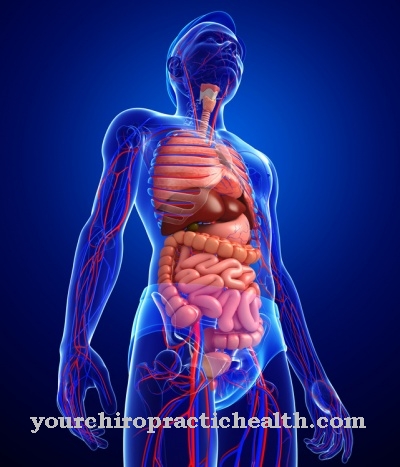Of the junctional substitute rhythm of the heart begins as soon as the normal rhythm generator, the sinus node in the right atrium, fails or the preset frequency falls below about 60 Hz. The stimulus is generated in the zone connecting the atrioventricular node (AV node), bundle of His and the right atrium, since the AV node itself does not have any automatic spontaneous depolarization. The junctional substitute rhythm shows a typical rhythm of 40 to 60 Hz.
What is the junctional substitute rhythm?

The primary stimulation of the heart comes from the sinus node, which is located in the wall of the right atrium at the point where the superior vena cava joins. The junctional substitute rhythm serves as a secondary cardiac pacemaker. It starts from the connecting region AV node, bundle of His and the right atrium, since the AV node itself does not show any spontaneous polarization and is therefore unsuitable as a clock generator.
The junctional substitute rhythm always jumps in automatically as a safeguard if the electrical stimuli of the sinus node fail for a period of a little more than a second. Due to its typical natural frequency of 40 to 60 discharges per second, the substitute rhythm takes over the command not only in the event of a total failure of the sinus node, but also in cases in which the specified frequency drops below the natural frequency of the junctional substitute rhythm.
When the substitute rhythm is activated, the atria are usually not excited or only directed backwards (retrograde). This is noticeable in the ECG by the absence of the P wave or by a negative P wave. The P wave represents the course of excitation in the atria and appears in the ECG in people with normal sinus rhythm in front of the QRS complex with the distinctive R wave.
Function & task
The heart's junctional substitute rhythm has an extremely important and in certain situations even life-saving function. There are a variety of causes that can lead to sinus node dysfunction. The causes lie in or on the heart (cardiac) or completely outside the heart (extracardiac).
Circulatory disorders due to coronary heart disease, heart valve defects, inflammatory and degenerative processes within the heart as well as cardiac muscle diseases are typical cardiac diseases that can trigger a manifest cardiac arrhythmia that initially originates from the sinus node. All circumstances and illnesses that can affect the sinus rhythm are summarized under the term sick sinus syndrome.
The “jumping in” of the junctional substitute rhythm can be life-saving in these situations. Typical causes of disorders of the sinus rhythm that lie outside the heart can be, for example, diseases of the thyroid gland, disorders of the hormonal balance, febrile diseases and pulmonary embolism.
Although the excitation generation and the conduction of the heart are largely autonomous, the heart's beat frequency and the amount of blood delivered per unit of time must be able to adapt to the requirements. which is why, for example, messenger substances of the sympathetic and parasympathetic nervous system as well as some hormones can influence the control of the heart rhythm and blood pressure.
This means that not only hormonal disorders can have a negative impact, but also drugs (in the form of undesirable side effects) and neurotoxins can lead to significant cardiac arrhythmias and impaired function of the sinus node. The extracardiac disorders category also includes electrolyte disorders, especially potassium deficiency, which can disrupt the primary heart rhythm.
There is a special situation with electrical accidents, since electrical accidents do not occur in nature on land, except for very rare lightning accidents. For this reason, no protective mechanism has developed within evolution that could offer the cardiovascular system appropriate protection. In these cases, too, the junctional substitute rhythm is available as a safeguard for the primary pacemaker sinus node and can be life-saving under certain circumstances.
Illnesses & ailments
The junctional substitute rhythm usually does not come into action because it is overridden by the faster sinus rhythm. The electrical impulses of the sinus node reach the AV node before the self-depolarization can set its own electrical impulse from the connecting regions to the bundle of His.
If the sinus node is functioning normally, the junctional substitute rhythm does not pose any discomfort or danger. However, dangers in connection with the junctional replacement rhythm can arise in the presence of the mostly genetic Wolf-Parkinson-White syndrome (WPW syndrome) or a so-called AV block. Symptomatic of WPW syndrome are electrical excitations that circulate between the atria and the ventricles.
The cause of the circulating currents is one or, in very rare cases, several additional conduction pathways that directly connect the atria with the ventricles so that the AV node is electrically bridged. The creation of the additional conduction path between atrium and ventricle is genetically determined, but does not necessarily trigger the WPW syndrome. It is most common in those in their twenties to thirty years. Symptomatic of the syndrome is an occasional palpitations (tachycardia).
An AV block, on the other hand, involves a delayed, temporary or permanent interruption in the transmission of electrical impulses from the atria to the ventricles. AV blocks can arise due to congenital abnormalities of the heart or can be acquired later. The causes include inflammatory processes in the heart, autoimmune diseases or side effects of drugs. Antiarrhythmics, cardiac glycosides and beta blockers in particular can cause AV block. In the case of drug side effects, however, the AV block is reversible in most cases.
AV blocks are classified into severity levels I, II, and III. A first-degree AV block is merely a delayed transmission of the signal for more than 200 milliseconds, which can be seen in the ECG from the time between the termination of the P wave (contraction of the atria) and the onset of the QRS complex leaves. A second-degree AV block is characterized by the fact that atrial contractions are not transmitted at regular or irregular intervals and the ventricular contraction then ultimately fails. In a block III. In the 2nd degree, the contraction signal to the ventricles can fail completely, so that the ventricular replacement rhythm usually sets in as a second endogenous safeguard.



























